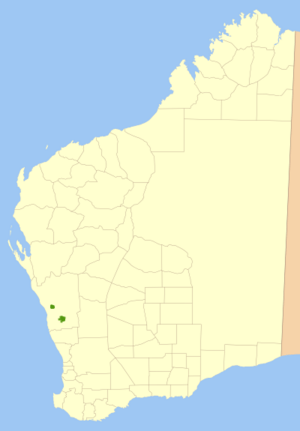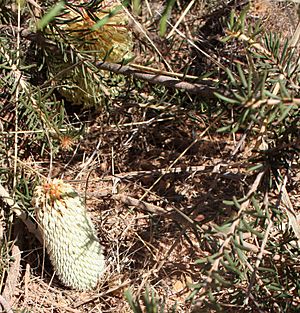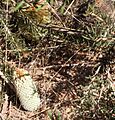Burma Road banksia facts for kids
Quick facts for kids Burma Road banksia |
|
|---|---|
 |
|
| Scientific classification | |
| Kingdom: | |
| (unranked): | |
| (unranked): | |
| Order: | |
| Family: | |
| Genus: | |
| Subgenus: | |
| Section: | |
| Series: | |
| Species: |
B. scabrella
|
| Binomial name | |
| Banksia scabrella A.S.George
|
|
The Banksia scabrella, also known as the Burma Road banksia, is a type of woody shrub. It belongs to the Banksia group of plants. This plant is part of a series called Abietinae. This group includes several shrubs with small, round, or oval flower clusters.
You can find the Burma Road banksia in a few separate areas south of Geraldton, Western Australia. The biggest group grows south and east of Mount Adams. It likes sandy soils in areas with low shrubs or heathland. This plant can grow up to 2 meters (7 feet) tall and 3 meters (10 feet) wide. It has thin, needle-like leaves. Its flowers appear in spring and summer. They are round to oval, tan to cream in color, with purple parts. The Burma Road banksia dies in a fire but grows back from its seeds.
This plant was first collected in 1966. For a while, people thought it was just a different form of another banksia, Banksia sphaerocarpa. But in 1981, a banksia expert named Alex George officially described it as its own species. Like many plants in the Abietinae group, it's not often grown in gardens. However, experts say it has good potential for gardening.
Contents
What Does the Burma Road Banksia Look Like?
The Burma Road banksia is a low shrub that spreads out. It can reach about 2 meters (7 feet) tall and 3 meters (10 feet) wide. Its side branches often lie on the ground.
Leaves and Flowers
Its small, thin leaves are packed closely along the stems. They are about 0.8 to 2.8 centimeters long and 0.1 centimeters wide. The plant usually flowers in spring and summer, from September to January. However, some records show it blooming in April.
The flowers grow in "flower spikes" or inflorescences. These spikes are made of hundreds of tiny flowers called florets. They are tightly packed around a woody center. These flower spikes are quite easy to spot. They grow at the ends of branches or on short side branches. They are round or oval, cream or tan in color. They measure 3 to 6 centimeters (1.2–2.4 inches) tall and 7–9 centimeters (2.8–3.6 inches) wide.
The individual flowers are light yellow or cream. Their styles (a part of the flower) and upper parts are purple. The flowers are 2.7 to 3.5 centimeters (1–1.6 inches) long. The pistils (female parts) are 3.4 to 4.5 centimeters (1.6–1.8 inches) long and curve at the tip. As the flower spikes get older, they turn grey. The old flowers stay on the plant.

Seeds and Seedlings
Up to 80 seed pods, called follicles, can grow on one spike. These pods stay closed until a bushfire opens them. They are oval-shaped and measure 1.8–2.8 centimeters (0.7–1.1 inches) long. They are 0.5–0.9 centimeters (0.2–0.4 inches) high and 0.6–0.8 centimeters (0.2–0.3 inches) wide.
When they open, they release a dark brown, oval seed. The seed is 1.3–1.5 centimeters (0.5–0.6 inches) long and 0.4–0.5 centimeters (0.2 inches) wide. It has a thin, papery dark "wing" that is 1.4–2.4 centimeters (0.6–1 inch) wide. Young plants, called seedlings, have bright green cotyledons (seed leaves). These are 1.2–1.4 centimeters (0.5–0.6 inches) long. The first true leaves that grow are thin and spread out. The stem of the seedling is hairy.
How Scientists Classify the Burma Road Banksia
The Banksia scabrella was first collected on September 4, 1966. It was found southeast of Walkaway. Alex George, a famous banksia expert, officially named and described it in 1981. He chose the name scabrella because it comes from a Latin word meaning "rough." This refers to the plant's leaves.
George placed B. scabrella into the Banksia subgenus because of its flower spike. He put it in the Oncostylis section because its flower styles are hooked. He also placed it in the Abietinae series, which includes banksias with round fruits.
At first, George thought its closest relative was Banksia leptophylla, which grows in the same area. Later, he felt it was more closely related to Banksia lanata. That plant has similar colored flowers but longer, smooth leaves. For a long time, many new species, including B. scabrella, were simply thought to be different forms of Banksia sphaerocarpa.
Scientists use different ways to classify plants. In 1996, botanists Kevin Thiele and Pauline Ladiges suggested a new way to group banksias. They looked at the plants' physical features. They agreed that the Abietinae series was mostly correct. However, they divided it into smaller groups. Banksia scabrella was placed in one of these new groups. This group also included B. lanata and two types of B. leptophylla.
Later, in 1999, Alex George went back to his original classification system for banksias. He put B. scabrella back into the Abietinae series as he had first defined it.
In 2002, American botanists Austin Mast and Tom Givnish used DNA analysis to study banksias. Their findings supported Alex George's idea. They showed that B. scabrella is closely related to B. lanata, both types of B. leptophylla, and B. telmatiaea. B. grossa was a more distant relative.
Where Does the Burma Road Banksia Grow?

The Banksia scabrella grows in two separate areas. The first area found is southeast of the small town of Walkaway, which is south of Geraldton. A larger group of these plants is found southeast of Mount Adams in Western Australia.
The amount of rain in these areas is about 450 millimeters (18 inches) per year. This plant is on the "Declared Rare and Priority Flora List." It's listed as "Priority Four – Rare." This means it's rare, but it's not currently in danger from known threats. Plants on this list need to be checked every 5 to 10 years. Many groups of these plants are large, with over 100 plants. However, more than half of all known B. scabrella plants grow along roadsides.
The Burma Road banksia grows in deep, pale yellow or white sand. It likes kwongan scrubland and heathland. It can be found on flat areas or gentle slopes. It often grows alongside B. leptophylla and a smaller version of B. attenuata.
How Does the Burma Road Banksia Live?
Most plants in the Proteaceae family, including all Banksia species like B. scabrella, have special roots called proteoid roots. These roots have many short, dense side roots that form a mat just under the leaf litter. These roots are very good at taking in nutrients from poor soils. This is especially helpful in Australia's native soils, which often lack phosphorus.
However, B. scabrella is very sensitive to a plant disease called Phytophthora cinnamomi dieback. This disease can kill the plant.
Fire and Regeneration
When there's a fire, the Banksia scabrella dies. But it grows back from its seeds afterward. Records show that new seedlings can start flowering two or three years after a bushfire. However, there aren't many records of this.
Scientists haven't recorded specific animals that pollinate B. scabrella flowers. But generally, banksia flowerheads attract many different birds, mammals, and insects.
The area between Geraldton and Gingin is rich in Abietinae banksias. Nine different species grow there. Even so, their growing areas and habitats don't overlap much. Banksia scabrella is unusual because it grows in the same places as B. leptophylla. It also grows near an endangered heath shrub called Leucopogon marginatus.
The Burma Road Nature Reserve is one of the few protected areas where this plant grows. In this reserve, Banksia scabrella is most common in a mallee sedgeland. This area has a ground cover of the cord rush Ecdeiocolea monostachya. It also has the mallee tree Eucalyptus eudesmoides growing taller than the other plants. You can sometimes find B. scabrella in acacia scrub-heath areas. It's rarely found in thick acacia bushes or banksia woodlands.
A study looked at how climate change might affect this species. It found that the area where B. scabrella grows is unlikely to shrink. In fact, it might even get bigger. This depends on how well the plant can move into new areas that become suitable for it.
Growing Burma Road Banksia in Gardens
You don't need to do anything special to the seeds before planting them. They usually sprout in 14 to 16 days. The Burma Road banksia is not often grown in gardens. It takes about 3 to 5 years for it to flower from seed.
There isn't much information about how well it grows in gardens. But it has been grown successfully in South Australia. It grows fast but can become a bit messy. Regular trimming would help keep it neat. Some wild forms of the plant grow more compactly. These types would be better for gardening.
Images for kids






